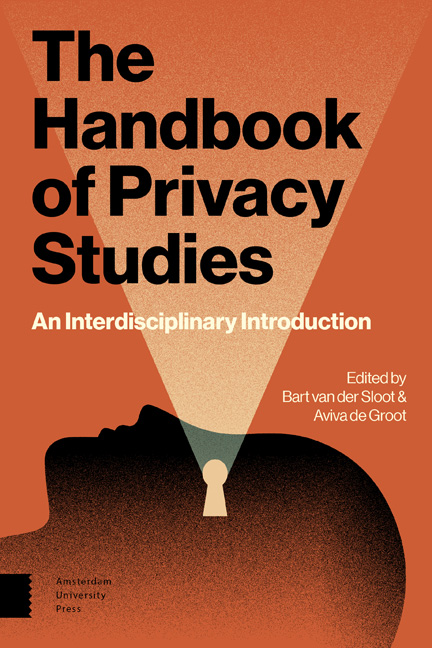Book contents
- Frontmatter
- Contents
- Introduction
- 1 Privacy from a Historical Perspective
- Legislating Privacy: Technology, Social Values, and Public Policy
- 2 Privacy from a Legal Perspective
- Three Dimensions of Privacy
- 3 Privacy from an Ethical Perspective
- Nudging: A Very Short Guide
- 4 Privacy from an Economic Perspective
- Security, Privacy, and the Internet of Things (IoT)
- 5 Privacy from an Informatics Perspective
- Political Science and Privacy
- 6 Privacy from an Intelligence Perspective
- A Privacy Doctrine for the Cyber Age
- 7 Privacy from an Archival Perspective
- Medical Privacy: Where Deontology and Consequentialism Meet
- 8 Privacy from a Medical Perspective
- Privacy Law – on the Books and on the Ground
- 9 Privacy from a Media Studies Perspective
- Diversity and Accountability in Data-Rich Markets
- 10 Privacy from a Communication Science Perspective
- Still Uneasy: a Life with Privacy
- 11 Privacy from an Anthropological Perspective
- About the Authors
Still Uneasy: a Life with Privacy
- Frontmatter
- Contents
- Introduction
- 1 Privacy from a Historical Perspective
- Legislating Privacy: Technology, Social Values, and Public Policy
- 2 Privacy from a Legal Perspective
- Three Dimensions of Privacy
- 3 Privacy from an Ethical Perspective
- Nudging: A Very Short Guide
- 4 Privacy from an Economic Perspective
- Security, Privacy, and the Internet of Things (IoT)
- 5 Privacy from an Informatics Perspective
- Political Science and Privacy
- 6 Privacy from an Intelligence Perspective
- A Privacy Doctrine for the Cyber Age
- 7 Privacy from an Archival Perspective
- Medical Privacy: Where Deontology and Consequentialism Meet
- 8 Privacy from a Medical Perspective
- Privacy Law – on the Books and on the Ground
- 9 Privacy from a Media Studies Perspective
- Diversity and Accountability in Data-Rich Markets
- 10 Privacy from a Communication Science Perspective
- Still Uneasy: a Life with Privacy
- 11 Privacy from an Anthropological Perspective
- About the Authors
Summary
Feminism and privacy
Thirty years ago, I published a book about privacy that focused on the problems of American women: imposed domesticity, reproductive autonomy, harassment, sexual violence, and sexual liberty. Uneasy Access: Privacy for Women in a Free Society was not only the first book-length treatment of privacy by a philosopher to focus on women, it was the first book-length treatment by an academic philosopher to focus on any aspect of privacy.
My book was a response both to the academic debates about the meaning and value of privacy found in analytic-style philosophy journals; and to feminist critiques of privacy emanating from many disciplines, well represented in legal scholarship by Catharine MacKinnon. Writing about abortion privacy doctrines in US constitutional law, MacKinnon had dismissed privacy as ‘an injury got up as a gift’ – a patriarchal value representing and facilitating the continued subordination of women in inferior social, political, and economic roles.
While conceding the women have historically lived their lives as ancillaries and inferiors, I argued in Uneasy Access that they have had ‘too much of the wrong kind of privacy’. Women have suffered, for example, isolation, confinement, and imposed domestic roles. What they merit morally and politically are ‘the right kinds of privacy’, namely, meaningful opportunities for voluntary seclusion, intimacies, and legal rights of decision about personal life and health. As a counterpoint to 1980s feminism, which over-disparaged privacy, I turned to 19th-century utopian writer Charlotte Perkins Gilman, who understood that true privacy for women would further equality and entailed radical transformation. Subsisting without alternatives in separate family houses to cook, clean, and take of others is not meaningful privacy.
To deepen the legal dimensions of the story, a few years later I published ‘How Privacy Got its Gender’, a law review article co-authored with one of my students. The article was based on a realization that the development of the US tort and constitutional law of privacy was in important respects driven by concerns about the proper regard for and place of women. Problematically, in the 19th and early 20th centuries, the impetus behind the expansion of privacy law was often to protect ideals of women's modesty and domesticity.
- Type
- Chapter
- Information
- The Handbook of Privacy StudiesAn Interdisciplinary Introduction, pp. 409 - 412Publisher: Amsterdam University PressPrint publication year: 2018



